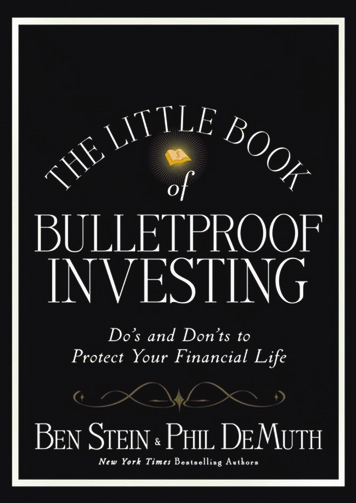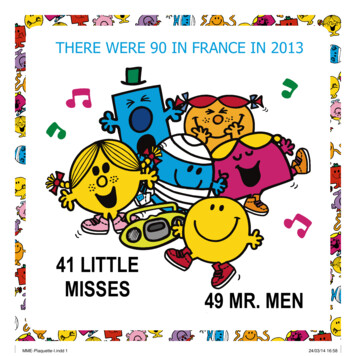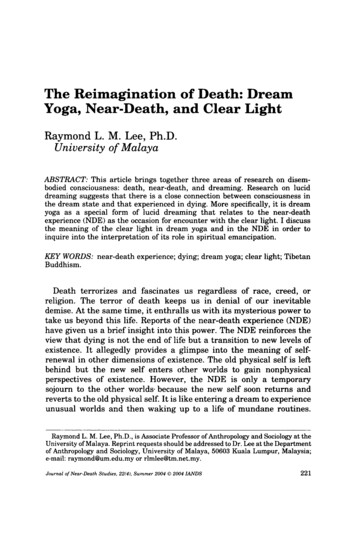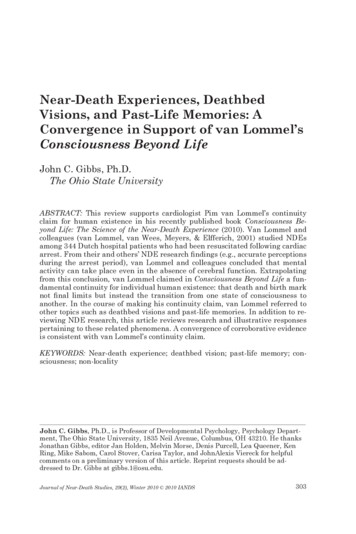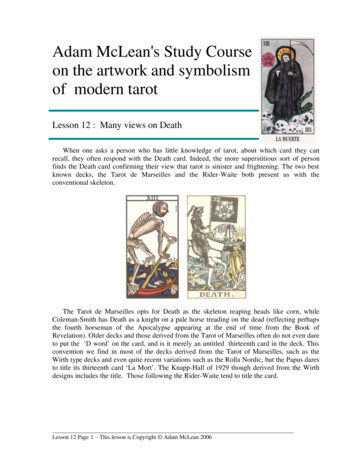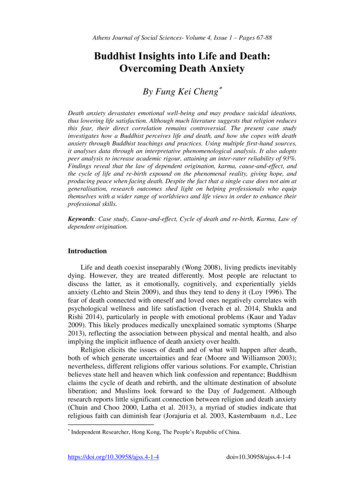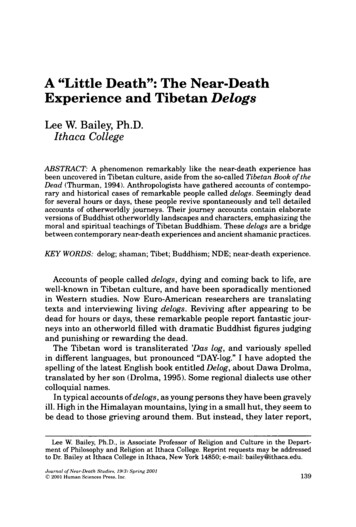
Transcription
A "Little Death": The Near-DeathExperience and Tibetan DelogsLee W. Bailey, Ph.D.Ithaca CollegeABSTRACT: A phenomenon remarkably like the near-death experience hasbeen uncovered in Tibetan culture, aside from the so-called Tibetan Book of theDead (Thurman, 1994). Anthropologists have gathered accounts of contemporary and historical cases of remarkable people called delogs. Seemingly deadfor several hours or days, these people revive spontaneously and tell detailedaccounts of otherworldly journeys. Their journey accounts contain elaborateversions of Buddhist otherworldly landscapes and characters, emphasizing themoral and spiritual teachings of Tibetan Buddhism. These delogs are a bridgebetween contemporary near-death experiences and ancient shamanic practices.KEY WORDS: delog; shaman; Tibet; Buddhism; NDE; near-death experience.Accounts of people called delogs, dying and coming back to life, arewell-known in Tibetan culture, and have been sporadically mentionedin Western studies. Now Euro-American researchers are translatingtexts and interviewing living delogs. Reviving after appearing to bedead for hours or days, these remarkable people report fantastic journeys into an otherworld filled with dramatic Buddhist figures judgingand punishing or rewarding the dead.The Tibetan word is transliterated 'Das log, and variously spelledin different languages, but pronounced "DAY-log." I have adopted thespelling of the latest English book entitled Delog, about Dawa Drolma,translated by her son (Drolma, 1995). Some regional dialects use othercolloquial names.In typical accounts of delogs, as young persons they have been gravelyill. High in the Himalayan mountains, lying in a small hut, they seem tobe dead to those grieving around them. But instead, they later report,Lee W. Bailey, Ph.D., is Associate Professor of Religion and Culture in the Department of Philosophy and Religion at Ithaca College. Reprint requests may be addressedto Dr. Bailey at Ithaca College in Ithaca, New York 14850; e-mail: bailey@ithaca.edu.Journal of Near-Death Studies, 19(3) Spring 2001O 2001 Human Sciences Press, Inc.139
140JOURNAL OF NEAR-DEATH STUDIESthey had risen up above their bodies, which then they did not recognizeas their own. Theirs is an archaic example of a mystical experience ofthe after-death state. Delog deaths are an extraordinary tradition inTibetan culture, strikingly akin to the near-death experience (NDE).Next these persons' dazed souls enter into a raucous hereafter, guidedby their personal deity. They are taken to meet the horrifying Lord ofDeath himself. They are led on a shocking tour of Hell, where they seenumerous condemned souls miserably suffering punishments befittingtheir sins, such as the nun who hears the unending cries of her own babywhom she murdered. The anguished sinners send urgent messages backto the living, begging family to do rituals to aid in their salvation andexhorting others to live an ethical life. The astonished travelers meetdeceased parents and travel to paradise. Returning to the throne ofthe Lord of Death, they observe the dreadful judgment of souls witha bridge, a scale, or a mirror. They themselves are judged and givena message to send back. Their consciousnesses return to their bodieson earth. They deliver the various messages and exhort all to practicetheir Tibetan Buddhist religion faithfully.Such accounts of the Tibetan delogs are astoundingly akin to what wein the West call near-death experiences. But there are revealing differences with important implications. Sogyal Rinpoche discussed the delogphenomenon in The Tibetan Book of Living and Dying (Sogyal, 1993).He reported that "In Tibet this was an accepted occurrence, and elaborate methods were devised for detecting whether ddloks were fraudulent or not" (Sogyal, 1993, p. 331). Earlier studies include articles byLawrence Epstein (1982), Kenneth Ring (1993), and Christopher Carr(1993). I will discuss their views below.There are historical records of delogs and contemporary studies ofliving delogs. Usually women, delogs have a revered place in Tibetanpopular religion, although they may be neglected by some Buddhists.Historically, Buddhism was introduced to Tibetan culture from India inthe 7th century C.E. The Indian master Padmasambhava was then invited by the King of Tibet in the 8th century. In order to bring Buddhismto Tibet, Padmasambhava had to contend with the native Bon religion, and some of the resulting traditions spiritualized these earliertribal shamanic practices. The first Buddhist monastery was founded in775 C.E. Later the leadership focused on the Dalai Lama, who was seenas the bodhisattva Avilokiteshvara in human form, living in the Potalapalace in Lhasa. Although the delogs remained on the fringe of rural, archaic, Himalayan tradition, they absorbed much of the new Buddhism.Following Epstein, the most notable anthropologist to study delogswas the French anthropologist Frangoise Pommaret (1989), the first
LEE W BAILEY141Westerner to do a book-length study, Les revenants de l'au-dela dansle monde Tibetain: Sources litteraires et tradition vivante [Those whoreturn from the hereafter in the Tibetan world: Literary sources andliving tradition]. She traveled often to the Himalayan highlands justsouth of Tibet, still accessible despite the 1959 Chinese invasion ofTibet, and part of Tibetan culture. In Nepal and Bhutan she discoveredhistorical records of ten delogs from the 11th to the 20th century. Shethen interviewed a delog in a village in Nepal and three in Bhutan.The other new book about a delog is the English account of DelogDawa Drolma, who lived in Tibet around 1900 to 1941 and recorded herdramatic journeys to the hereafter with the aid of a scribe. Her bookDelog: Journey to Realms Beyond Death was translated into Englishin 1995. Wandering Himalayan storytellers (mani pa) are also knownfor retelling these incidents (Pommaret, 1989). Delog accounts becamea Tibetan literary genre by the 16th century, but they are just nowreaching a global audience.Historical TextsPommaret's studies of historical delog texts from the 12th to the 20thcenturies included a notably detailed story of a delog whose biography was based on a 17th-century manuscript (Thimphu, 1980). Thismanuscript, like many others, was from a private collection studied byPommaret. Since so many texts were carried from Tibet by exiles whenthe Chinese invaded, libraries are incomplete, although the Tibetan Library of Works and Archives in Dharamsala, India, now houses at leasta dozen accounts of delogs. In this case, the text (Thimphu, 1980) wasa 193-page book, but has no colophon giving more publication details.The 17th-century original date was deduced by Pommaret (1989) fromother references.Chos 'dzom ("Chonzom")Sangs Rgyas chos 'dzom of Bhutan lived soon after 1650. As a 12year-old girl, she said that the bodhisattva Avilokiteshvara told her thatshe had seven days to travel in the 18 realms of the hereafter. Feelingblessed, she was taken to his paradise, Mount Potala. Returning home,she heard her immensely sad parents say that she was dead. She sawher own corpse, but cried because it was a pig! She met her yi dam (personal divinity) who guided her, saying, "Do not be attached to your bodyof illusion; lift your spirit towards the essence of things. Follow me." He
142JOURNAL OF NEAR-DEATH STUDIEStook her hand, assuring her with the classic Buddhist mantra "Om manipadme hum" ("Hail, the jewel in the lotus") (Pommaret, 1989, p. 32).Taken to the first realm between incarnations (bardo), she witnessedthe terrible suffering of the dead. Vast numbers of people were experiencing painful retribution matched to their sins. But she and her yidam entered a place of pure white light. All the mountains, valleys, andbodies of the dead were glowing pure white. A dazzling, white divinityhad a shocking white face. Soon she saw more terrifying divinities ofyellow, red, and green, and she fainted. Revived, she traversed a bridgeover an ocean of fire, where she witnessed an ox-headed acolyte of theLord of Death beating some tied-up victims for having eaten meat. Further on, she saw several dazzling beams of light, leading to regions ofvarious Buddhas, gods, demi-gods, humans, and animals.But first she had to meet the horrifying Lord of Death, Yama. Protected by her personal divinity, she entered his palace and trembled asshe saw his ugly, red face, wide-eyed and fanged. Wearing a tiger skin,skulls, and flames, he held the fateful mirror of existence, a sword, andwater. His frightening voice rumbled like a thousand dragons. He wasattended by numerous ugly, animal-headed acolytes and a nasty, little, black demon holding black pebbles signifying the sinful deeds ofeach poor person to be judged. But a white deity held white pebblesthat would weigh against the black deeds. This vast army of beasts waschanting "execute! execute!" or whacking off the heads of the weepingvictims.Our horrified traveler fainted, but was revived and told by her protective guide that all these suffering ones were receiving their retributionfor having killed while on earth. But the faithful would not suffer so. Shewas told by the Lord of Death that, according to the mirror of existence,she had been dead seven days, and that it was now time for her to returnto the land of the living. Her task was to be a messenger between theliving and the dead. Furthermore, she was told that she was the incarnation of Avalokiteshvara Mahakaruna and she was to explain to humans the bardos and the 18 hells in detail without hiding anything. Shewas to give grave warnings from the Lord of Death about punishmentsfor such moral trespasses as infanticide, adultery, greed, black magic,and war. He urged serious religious practices, such as meditation: "Youmust inspire all people to practice religion" (Pommaret, 1989, p. 65).He foretold that she would return for her final death at age 50, but shemust hurry back, because her family was about to cremate her corpse.Chos 'dzom immediately returned to her village, Za chu sgang, andsaw her corpse. She then lost consciousness and a man said that the
LEE W. BAILEY143heart of her corpse was now warm. She awoke and soon the entirevillage was exclaiming: "The girl has returned from the land of thedead" (Pommaret, 1989, p. 66). Some skeptics accused her of not tellingthe truth, but many gathered around her urging her to tell what shesaw in the bardo. She told of her journey while dead for seven days,seeing the 18 hells and all the paradises. Finally, she stressed thatthe message of the Lord of the Dead is more joyous and precious thangold. Her experience demonstrates the typical elements of the delogphenomenon.Living DelogsIn addition to the studying historical texts, Pommaret interviewedseveral living delogs. She interviewed at least four living delogs inthe 1980s. In Bhutan, in the village of Wamrong, she interviewed athin, wrinkled elderly woman, Rizing Gyelmo, who was surprised thatstrangers would be interested in her. In 1982, she was 78 years old.She had been married to a peasant and had four children, all now married with children. Her husband had died in 1972, and she now livedwith two sisters. Rizing reported that she "died" first at the age of fivemonths, after a grave illness. She "died" and returned later, but at theage of 13 she had the revelation that she was a delog, and an incarnation of the bodhisattva Avalokiteshvara. She emphasized that onlyin the old days did the delogs die for several days. Now she was one ofthose who die for only a few hours, so she should actually not be called adelog, but a nyin log, meaning "returning in one day." Pommaret (1989)witnessed her during a three-hour stance when she chanted a very longcall to the dead to come forth.A second delog, found in the village of Khamdang, was named KarmaWangzom. As an infant she had been mistreated by a drunken father,she said, and had "died" several times. At the age of 13 she became adelog. She stopped eating garlic, onions, pork, fish and eggs. She began to "die" on fasting days, the 10th, 15th, and 30th of each month.She would "die" for three or six hours, beginning at 6:00 in the morning. On her return she sang the messages from the dead and the Lordof the Dead. She said that she had not received particularly religiousteachings before becoming a delog. Some villagers said that this deloghad suffered from epilepsy but had succeeded in controlling it. Thisraises the question of the role of illnesses such as epilepsy in delog-liketraditions. In his classic study of shamanism, Mircea Eliade (1951) discovered that illnesses such as epilepsy were often characteristic of tribal
144JOURNAL OF NEAR-DEATH STUDIESspiritual healers. Among the Siberian Voguls, for example, "the futureshaman.is sometimes even subject to epileptic seizures, which areinterpreted as meetings with the gods" (Eliade, 1951, p. 15). Or, "Oftenwhen the shaman's or medicine man's vocation is revealed through anillness or an epileptoid attack, the initiation of the candidate is equivalent to a cure" (Eliade, 1951, p. 27). Eliade concluded:Whether he is chosen by gods or spirits to be their mouthpiece, or ispre-disposed by this function by physical defects, or has a hereditythat is equivalent to a magico-religious vocation, the medicine man [orwoman]. has more direct relations with the sacred.Infirmity, nervous disorder, spontaneous vocation, or heredity are so many externalsigns of "choice," an "election." (1951, p. 31)So to Eliade, a delog having epilepsy would not be discrediting. It wouldlikely be a mark of being called into the sacred realm of her vocation.In the Bhutanese village of Maidung an 18-year-old girl lived on aprosperous farm and dressed in a Tibetan robe, indicating a religiousvocation. She told Pommaret that she was named Choekyi Wamgmo bythe Lord of the Dead. She had "died" often as a child, and at age 14she proclaimed herself a delog. Like others, she was considered to bethe reincarnation of an earlier delog. According to the local custom ofsororal polygyny, she had a daughter by her sister's husband. She didnot wish to live a conventional married life, so she made herself a stoneretreat hut where she lived with her child, devoting herself to the religious life. Having a daughter, she said, she was unable to visit certainparts of the otherworld. Now she "died" on the 10th, 25th, and 30th ofthe lunar month. Many people from the region came to her for advice.Some believed that her "deaths" resembled epileptic crises.Pommaret (1989) learned that various delogs have been reported tohave a cold heart and a cold body, or a slow heartbeat during theirjourneys to the land of the dead. They then return with news of thedeceased for their families. One man from Tongsa, in central Bhutan,who was blind, was a renowned delog who "died" on the 15th and 30th ofeach month and returned, reporting the news of people's dead parents,the causes of illnesses, and of the future. Pommaret (1989) includedphotographs of some of these delogs in her book.In the Bhutanese valley of Chumey a Bumthang in 1977-1978 aboy was born to a family of poor peasants. His mother later died andhis father remarried. The unhappy boy ran away to the monastery ofPetsheling a Bumthang Choekhor, to join an uncle. There he fell ill and"died" in 1985. He was returned to his family where he "died" a second
LEE W BAILEY145time and reported that he saw his mother. His father called his visiondemonic and beat him, but the villagers declared the boy a delog. Hewas sent to the monastery at Nyimalung, where he studied briefly, butthe little 8-year-old failed to persuade the people outside his village ofthe validity of his experience, so he was sent home to become a cowherd(Pommaret, 1989).Influences Behind the Delog AccountsHistorically, large portions of Hinduism were adopted by Buddhism,especially in the area of cosmology, so it is no surprise that their pictures of the infernal realms are very similar (Pommaret, 1989). ManyHindu details, such as the names of various hells, and the image of thecopper cauldrons for cooking the condemned, can be found the BuddhistTraite de la Grand Vertu de Sagesse, from around the 3 rd century A.D.(Pommaret, 1989). Similarly, the archaic pre-Buddhist Bon tribal traditions may have also absorbed some older Hindu traditions.The way certain sins are highlighted and their punishments are madeto fit the sin reflects the issues of concern in traditional Tibetan society. For example, for practicing black magic, the punishment is to havea magic dagger plunged into the body. The delogs teach the Buddhistview that the families of the dead can help save them ritually by offering prayer flags, food, and water, and by decorating statues and recitingsacred texts. The delog scene of the judgment by the Lord of the DeadYama Dharmaraja reflects the background of Hindu Lord of the Dead,Yama, and his acolytes, the black and white pebbles, and the mirrorof truth. Retributive punishment may be cumulative, but it is temporary, and rebirth is certain, affirmed by the classic Hindu and Buddhistdoctrines of reincarnation and karma.Other details have a more uniquely Tibetan background, such as thetradition of the god and the demon born at the same time as a person(Pommaret, 1989). Although the traditional accounts of the delogs certainly has roots in the archaic Bon tribal religion in Tibet prior to theBuddhist influence, the literature of the delog now largely reflects muchorthodox Buddhism. Nevertheless, the delogs tend to be more part ofthe rural, popular religion than the highly literate monastic culture.The high goals of the monasteries strive to raise the consciousness ofstudents above the fear of punishment and direct them toward compassion and wisdom, detachment and meditative insight. This is partlywhy the monasteries do not encourage the delogs. They are acknowledged, however, as part of the larger spiritual community.
146JOURNAL OF NEAR-DEATH STUDIESThe delog focus on death is part of the considerable preparation fordeath in all of Buddhism. The so-called Tibetan Book of the Dead[BardoThodol(Thurman, 1994) is part of a large death literature in which students are taught to meditate on impermanence (Govinda, 1960). Subsequently, one's state of mind at the time of death is considered vitallyimportant, because it can determine what kind of rebirth a person willhave. "Strongly negative thoughts at the time of death-anger, resentment, or hatred, etc.-this can erase the effects of a lifetime of virtuous conduct and lead to a rebirth characterized by suffering" (Powers,1995, p. 305). Conversely, positive thoughts can reverse a lifetime ofnegativity.The descent to the underworld is one of the most universal themesof visionary experiences, and in India and China the literature on thistheme is considerable. In Tibet, the main forms are (1) the savior-figure,such as the famous disciple of Buddha, Maudgalyayana (Pommaret,1989) or the divine Alvalokiteshvara, or (2) the human delog. A commonChinese theme is the return of an ordinary dead person to life due tothe error of an infernal bureaucratic functionary (Pommaret, 1989).A theme parallel to ancient Iranian religion is the bridge over whichthe dead must cross. In ancient Persian Zoroastrianism it is called theChinvat bridge, which is wide and easy for believers to cross, but narrowas an upright razor for sinners (Pommaret, 1989).Tibet may have been influenced by traditions of shamanic otherworldjourneys from the Turkish-Mongolian culture. One text reported that"a slave of the Mongols had been plunged for seven days into a hypnotic sleep before being interrogated on his visions" (Pommaret, 1989,p. 99). Sleep was sometimes described by the Turkish Mongols as a"little death," as it is in Tibetan culture.Comparing the Delog and the Near-Death ExperiencePommaret (1989) outlined a typology of the delog adventure that canbe contrasted with many typical elements of the contemporary Westernnear-death experience.Presentation of the DelogFirst, the recitation of the delog story always begins with a shortprayer. The delog is presented by name, parents' names, and birthplace.
LEE W. BAILEY147For example:In Bhutan in the western province of Bkra shis sgang, in a place called'Phangs ri gsang gdun, lived a man Bsod nams don grub and a womanT she dgang rgyal mo who had all the signs of the dakini Ye shesmtsho rgyal. They had a daughter Sangs rgyas chos 'dzom who wasan incarnation of the boddhisattva Avalokiteshvara. (Pommaret, 1989,p. 67)Comparing this to contemporary near-death studies, we can see thatNDEs focus on the individual. Western individuality minimizes suchconcern for parents, birthplace, and the atmosphere of an ancient tribalsociety oriented to land and family. So by contrast, NDEs in a Westernindustrial society are more likely to focus on individuals and their livesthan on parents and birthplace. Nor are NDEs likely to have so stronga religious emphasis as to begin with a prayer. And Westerners wouldnot dare say that the near-death survivor was an incarnation of a divinefigure.Premonition Dream and DeathSome delogs experience a premonition dream and there may be anallusion to their intense desire to practice the religion of their ancestors.One premonition dream of Byand chub send ge went like this:A white boy advised me not to eat the food that people were eating. Ifollowed him and he sat in the center of a lotus of a thousand petals.He was surrounded by thousands of others. All recited the mantra Ommani padma hum (Hail, the jewel in the lotus). He gave me a liquidlike milk, saying that it was nectar. And he gave me a crystal rosaryand said: "Daughter . I am Avalokiteshvara" and he disappeared likea rainbow. (Pommaret, 1989, p. 68)Then an illness, often quite sudden, leads to the death of the delog.This dream centers on the symbolism of a Buddhist divine child,seated in the midst of a huge Buddhist lotus. He is the jewel in thelotus of the classic mantra. He is Avalokiteshvara, the bodhisattva ofcompassion as a child. His appearance in a dream is interpreted asa prelude to a journey to another realm. For Buddhists all reality isultimately mind, so dreams could possibly foretell later events. Butwhile some Westerners may be interested in dream interpretation, fewwould take a dream to be a premonition of literal events such as a neardeath experience. Influenced more by Sigmund Freud and Carl Jung,
JOURNAL OF NEAR-DEATH STUDIES148a Western view would more likely see such dreams only symbolically.Jung would see the child as the divine within, the Self.Realization of DeathAt first, the delogs may not realize that they are dead, when the spiritseparates from the body, leaving it seeming like an animal in the delog'sclothing. As the disembodied spirit roams about the home, the delog maynot understand why the rest of the family is acting so strangely andunresponsive to the delog's efforts at communication. The experienceof Gling Bza' chos skyid is typical:Then when I saw my own bed, there was the cadaver of a big pig coveredwith my clothing. My husband and my children and all the neighborsof the village arrived and began to cry. They began to prepare fora religious ceremony and I thought, "What are you doing?" But theydid not see me and I felt abandoned. I did not think that I was dead.(Pommaret, 1989, p. 70)Finally, the delog realizes that she or he actually is dead.Now the experience of the delog begins to sound more like a typicalnear-death experience. The out-of-body experience and the failure torealize one is dead are familiar, as well as feeling perplexed when peopledo not see or hear one's floating soul. Some also feel no attachment totheir dead bodies below, and are surprised to discover that the corpsebelow is theirs (Gibbs, 1997). Of course, the big difference in the delogexperience is that of seeing the body below as a pig, which is quite unlikea typical NDE. The pig is a Tibetan Buddhist symbol of ignorance anddelusion, pictured in mandalas such as the Wheel of Life (Blofeld, 1970).First Contact with the Other WorldNext the delogs have their first contact with the other world, therealm between life and death, or bardo, which seems like a countryside. They likely meet frightening acolytes of the Lord of Death. Theyfrequently meet their familiar protective divinity, the yi dam, who willbe their mentor in the infernal realms. In most accounts, the delogcrosses a bridge over an enormous river, marking the entry into theother world.When Chos'dzom met her protective deity (yi dam) and guide, he said,"Don't you know that you are dead? Don't show attachment to your bodyof illusion; lift your spirit towards the essence of things. Come where Iwill lead you" (Pommaret, 1989, p. 32). Then she met those terrifying
LEE W. BAILEY149creatures crying "execute! execute!" but was protected by her yi damand her mantra.The spiritual guide is sometimes part of the Western NDE, especiallyin the medieval versions, where angelic protectors guide the perplexedwanderers (Zaleski, 1987). Ring pointed out that "we have in our ownWestern tradition NDEs that are, almostpoint for point, the exact equivalent of the das-log experience in Tibet. I'm referring to the medievalperiod" (1993, p. 80). Dante's Divine Comedy (Alighieri, 1939/14th century) was the culmination of this tradition. In it he was first guided bythe literary Virgil, then the more transcendent Beatrice, whose "eyesshone brighter than the stars" (Alighieri, 1939/14th century, "Inferno,"II: 55). In the "Inferno," Beatrice said: "Only those things should befeared that have power to do us ill, nothing else, for nothing else is fearful, and I am made such by God of His grace that your misery does nottouch me nor a flame of the fires here assail me" (Alighieri, 1939/14thcentury, "Inferno," II: 89-93).Buddhists are urged as part of their basic education in life to developa relationship with their individual guiding deity, so they will recognizeit at death. But often contemporary NDErs are on their own, which maybe the source of innumerable subsequent difficulties in adjustment. Thebridge provides a border between life and death. In Western NDEs,however, is it more likely a point of no return, whereas for delogs, it isnot.Most Western religions, in the context of Western materialism, nowstruggle to transmit a sense of the transcendent. By contrast, TibetanBuddhism assumes the greater reality of the vast undying transcendentspaciousness surrounding earthly life. In Buddhist belief, this realm oflight is reality, and the earthly life, with its brief impermanence andsuffering, is ultimately an illusion. This is one of the most importantdifferences between the two religions.Description of the Infernal RealmsNext the delog is taken on a voyage into the infernal realm to observeand understand the tortures of karma. In an initial appearance beforethe Lord of the Dead, the delogs and their guides are invited to tourthe land of the unliving and then return before his throne. Often theysoon meet a familiar person, such as a parent or brother, whose transgressions and punishments are explained. Urgent requests for livingsurvivors to perform rituals to save the suffering are frequent. For example, Karma dbang 'dzin met her deceased brother, who was forced to
150JOURNAL OF NEAR-DEATH STUDIESbecome a cowherder. Having not studied his religion and learned rightfrom wrong behavior, he stooped to some wickedness in life and so hemust now suffer. He begged her to perform some rituals to assist in hisdeliverance, including serving tea at the monastery, copying and reading religious texts, and offering a hundred thousand sacrificial gifts tomeditating sages (Pommaret, 1989). Some delogs may observe scenesof deliverance; some travel in the higher realms of the gods, paradises,buddhas, and bodhisattvas; while others venture into the lower realmsof animals being reincarnated.While travelers in a Western NDEs may meet known persons, thereis little concern for the living doing rituals to aid the dead, outsidethe Mormon faith. In the West the request for the living to performrituals to save a dead individual from punishment is largely a historical memory of medieval tradition. Some contemporary NDEs, however, may be greatly concerned with collective moral issues, such asDannion Brinkley's prophetic visions of ecological and nuclear disasters (Brinkley and Perry, 1994). Individuals struggling with their ownmoral and spiritual issues, Brinkley saw, simply experience the painthat they caused others until they learn. They do not typically encounter the terrifying scenes of punishment pictured in delog experiences.ReappearanceBefore the Lord of the DeadThe sixth theme in the journeys of the delogs is the reappearance before Yama, the observation of several judgments, and the judgment ofthe delogs themselves. An important factor is that they have accumulated sufficient good karma in their previous lives so that the Lord ofDeath sends them back to live in their old bodies. Finally Yama conferson the delog a long list of warning messages for the living. One of thelongest was that delivered to Kun dga' rang grol, including:Transmit this message to lamas:. Let them attempt to be perfectguides for human beings. Transmit this message to governmentfunctionaries: do not give without reason illegal punishments, for it is areason to fall into hell. Transmit this message to nuns: renounce domestic tasks and force yourselves to practice religion. Transmit thismessage to the mani pa of the world: convert the royalty to Buddhismbut do not exaggerate your stories. Transmit this message to thelaity: respect your parents, offer food.be sincere, do not beat animals; if you look inside yourselves there are demons. Live so thatyou will have no shame in my presence. (Pommaret, 1989, p. 77)
their Tibetan Buddhist religion faithfully. Such accounts of the Tibetan delogs are astoundingly akin to what we in the West call near-death experiences. But there are revealing differ ences with important implications. Sogyal Rinpoche discussed the delog phenomenon in The



